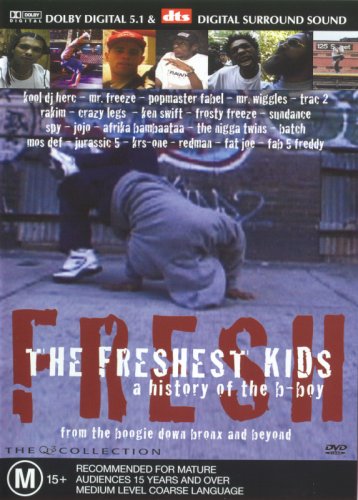Freshest Kids, The: A History of the B-Boy (2002) |
|
Freshest Kids, The: A History of the B-Boy (2002) |
|


|
| BUY IT |
| General | Extras | ||
| Category | Documentary |
Menu Animation & Audio Music Video-I'm Saying Though-S.W.A.T. Music Video-He's The Greatest DJ-Tony Touch f/Total Music Video-BattleZone-Mr. Animation f/Spontaneous & Sula Music Video-MC Delight-Grandmaster Caz Featurette-Uncut B-Boy Battles (3) Featurette-Original Style-Prince Ken Swift Featurette-New York City Breakers Featurette-Interviews; Trac 2, PopMaster Fabel, Kool DJ Here Featurette-The Hand Of Hip Hop (5) Featurette-Breaklife Promo Gallery Booklet |
|
| Rating |

|
||
| Year Of Production | 2002 | ||
| Running Time | 96:36 | ||
| RSDL / Flipper | Dual Layered | Cast & Crew | |
| Start Up | Menu | ||
| Region Coding | 2,4 | Directed By | Israel |
|
Studio
Distributor |
 Warner Vision |
Starring |
Afrika Bambaataa Mos Def Ken Swift Kool Herc Crazy Legs Frosty Freeze |
| Case | Amaray-Transparent-Secure Clip | ||
| RPI | $34.95 | Music | William Bannister |
| Video | Audio | ||
| Pan & Scan/Full Frame | Full Frame |
English Dolby Digital 5.1 (384Kb/s) English Dolby Digital 2.0 (192Kb/s) English dts 5.1 (768Kb/s) |
|
| Widescreen Aspect Ratio | None | ||
| 16x9 Enhancement | No | ||
| Video Format | 576i (PAL) | ||
| Original Aspect Ratio | 1.33:1 | Miscellaneous | |
| Jacket Pictures | No | ||
| Subtitles | None | Smoking | Yes |
| Annoying Product Placement | No | ||
| Action In or After Credits | No | ||
The Freshest Kids: A History of the B-Boy is a documentary film about the evolution of b-boying or as it became known in the mass media, break-dancing.
This documentary traces the underground dance phenomenon known as b-boying that began in New York in the 1970s. The movement quickly grew and in the early 1980s was discovered by the mainstream media. After being featured in films such as Flashdance and Beat Street, b-boying, or as it was then more commonly known, break-dancing, experienced a meteoric rise in popularity. Soon b-boys were seen on sidewalks and television screens across America and groups such as the Rock Steady Crew and The New York City Breakers became well-known figures.
Almost as quickly as b-boying came into the public arena it disappeared, but a small percentage of people continued to evolve the style. Recently there has been a resurgence in the popularity of b-boying and it is now common to see people breaking in modern music video clips and television commercials.
This documentary contains interviews with influential figures throughout the history of b-boying including The Nigga Twins, Spy, Ken Swift, Crazy Legs, Kool DJ Herc, KRS-One, Mos Def and Afrika Bambaataa. If you have any interest in b-boying or hip-hop in general this is definitely a documentary that is worth taking a look at.
This documentary contains numerous segments of archival footage and consequently the video quality does vary considerably during the transfer.
The transfer is presented at an aspect ratio of 1.33:1.
Throughout the transfer the image displayed is consistently slightly soft but this never poses any real problem. During a number of archival video segments, obvious low-level noise may be seen but this is expected and is not disruptive. Relatively poor levels of shadow detail may be seen during the dark sections of the transfer and this is slightly distracting.
The colours displayed during the transfer vary with the material presented. During the archival footage the colour palette is notably muted as expected but during the modern interview segments the palette is well saturated.
A small number of MPEG artefacts may be seen during the transfer. Examples of these artefacts are visible at 4:16, 9:27, 9:39 and 13:02 but these are all very minor and are not disruptive.
Numerous aliasing artefacts may be seen throughout the transfer. Some examples of these artefacts may be seen at 1:13, 4:06, 5:07, 6:19 and 7:31. A number of obvious moiré artefacts may also be seen during the transfer with obvious examples visible at 5:39 and 45:44. Due to the frequency and severity of these artefacts they are moderately disturbing.
A relatively large number of film artefacts may be seen during the archival footage during the transfer. Some examples of these artefacts may be seen at 6:32, 6:53, 6:59, 7:18 and 14:54. As these artefacts occur almost exclusively during the archival footage they are never disruptive. Obvious film grain may also be seen throughout the transfer and this is occasionally slightly annoying.
Unfortunately no subtitles are included on this disc.
The main feature and the extras are placed on separate layers and consequently no layer change is detectable by the viewer.
| Sharpness | |
| Shadow Detail | |
| Colour | |
| Grain/Pixelization | |
| Film-To-Video Artefacts | |
| Film Artefacts | |
| Overall |
The dialogue is occasionally muffled, due to the varied original source material, but always remains easy to understand.
During a short clip from the film Beat Street at 43:28 there is an obvious sync problem with all audio tracks. No other problems with audio sync or drop-outs were detected during the transfer.
As expected, the score supervised by William 'Rhandi' Bannister features numerous early hip-hop tracks and these obviously suit the action on-screen.
The surround channels are used minimally to support the score during the dialogue-driven interview-based feature. The LFE channel is used throughout to support the score.
| Dialogue | |
| Audio Sync | |
| Clicks/Pops/Dropouts | |
| Surround Channel Use | |
| Subwoofer | |
| Overall |
The animated menu is presented at an aspect ratio of 1.33:1.
This music video is presented at an aspect ratio of 1.78:1 and is not 16x9 enhanced. Three identical Dolby Digital 192 kbps 2.0 soundtracks are provided for the video.
This music video is presented at an aspect ratio of 1.78:1 and is not 16x9 enhanced. Three identical Dolby Digital 192 kbps 2.0 soundtracks are provided for the video.
This music video is presented at an aspect ratio of 1.78:1 and is not 16x9 enhanced. Three identical Dolby Digital 192 kbps 2.0 soundtracks are provided for the video.
This music video is presented at an aspect ratio of 1.78:1 and is not 16x9 enhanced. Three identical Dolby Digital 192 kbps 2.0 soundtracks are provided for the video.
This is a collection of three different b-boy battles. These battles are presented at an aspect ratio of 1.33:1 with three identical Dolby Digital 192 kbps 2.0 soundtracks.
This short clip about b-boy Ken Swift is presented at an aspect ratio of 1.33:1 with three identical Dolby Digital 192 kbps 2.0 soundtracks.
This clip is from the New York City Breakers 1997 Radio Tron Special Appearance and is presented at an aspect ratio of 1.33:1 with three identical Dolby Digital 192 kbps 2.0 soundtracks.
This collection of short interviews with various influential b-boys is divided into the following segments. The interview segments with Popmaster Fabel is divided into three separate parts. All interviews are presented at an aspect ratio of 1.33:1 with Dolby Digital 192 kbps 2.0 soundtracks.
This short promotion for Ken Swift's Breaklife is presented at an aspect ratio of 1.33:1 with three identical Dolby Digital 192 kbps 2.0 soundtracks.
This is a gallery containing twenty-one photographs of different b-boys and crews from the late 1970s to the modern day.
This is a gallery featuring 21 images of b-boys from different periods.
A short booklet provides a two page timeline of b-boying that spans from the early 1970s through to 2002 and also includes a chapter list and list of people the producers wish to thank.
NOTE: To view non-R4 releases, your equipment needs to be multi-zone compatible and usually also NTSC compatible.
Both versions of this DVD appear to be identical and I therefore would have no preference for either version.
As b-boying returns to popularity and finds its place within the hip-hop community, this documentary provides an excellent insight into the origins and influences of this unique dance style.
The video transfer displays a number of artefacts but this is to be expected due to the use of numerous clips of archival footage.
All of the soundtracks are able to easily reproduce the feature's dialogue-driven audio but the dts track is never able to clearly differentiate itself from the Dolby Digital 5.1 track and its inclusion is really superfluous.
The large collection of extras provides some interesting additional information that will be appreciated by any fan of the main feature.
| Video | |
| Audio | |
| Extras | |
| Plot | |
| Overall |
| Review Equipment | |
| DVD | Toshiba 2109, using S-Video output |
| Display | Sony KP-E41SN11. Calibrated with Video Essentials. |
| Audio Decoder | Built in to amplifier/receiver. Calibrated with Video Essentials. |
| Amplification | Front left/right: ME75b; Center: DA50ES; rear left/right: DA50ES; subwoofer: NAD 2600 (Bridged) |
| Speakers | Front left/right: VAF DC-X; Center: VAF DC-6; rear left/right: VAF DC-7; subwoofer: Custom NHT-1259 |